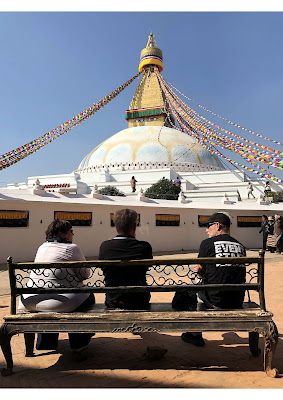Modern Boudhanath
After finishing 5 kora at Boudha
stupa, I went to one tea stall. The taste of the tea was so good and it was made
by an old lady, around my grandma’s age. I asked her about the background story
of Boudha during her childhood. She
started telling me the story of Boudhanath.
Once upon time, Boudha was a very
beautiful village adorned in all directions by thousands of trees and flowers,
blooming through all four seasons. Different kinds of insects made noises that
sounded like bells. Different birds tweeted like a melody-queen.
The main source of local peoples’
income was from agriculture. Almost 90 percent of people were farmers and all
the locals were Tamang. Usually, Tamang people worked very hard in the day time
but at the night they all needed to have rakshi (local whisky). Boudha’s local
people were living autonomously, a simple life.
After finishing the conversation
with the old lady, I got to know some back ground story of Boudha. It made me
reflect on the history of Boudha and how it has changed and evolved over the
years.
In the 50s and 60s, criminals of
Kathmandu started entering Boudha. They would commit crimes in the city and
then once the criminals crossed Chabhail (a neighboring suburb,) into Boudha, Kathmandu
police wouldn’t arrest them. This is how many of criminals from Kathmandu start
entering Boudha.
After the revolution in Tibet in 1959,
many Tibetan masters along with monks came to Nepal and settled in Boudha.
Afterward, Boudha started becoming a modern city. Many of the hippies or dharma-bums
around the 1970 came to Boudha in search of gurus, nirvana, liberation and
dharma. Before, there were hippies around Kathmandu valley, but one only found them
around Thamel and Basantapur. Most of the hippies were found enjoying marijuana
around Kathmandu and it was legal to buy it at the market at that time. Now in
Boudha, within this small area, there are people from more than 30 different
countries, Tibetans, Mongols, Americans, Taiwanese, and so on.
Chokyi Nyima Rinpoche, with his
long vision, established Rangjung Yeshe Institute, to study Buddhist philosophy
and meditation skills too. The students of Rangjung Yeshe are from different
backgrounds and are staying like one family. This is the benefit of the modern
world, where we can enjoy different people ideas, philosophies and histories
within one small community.





Comments